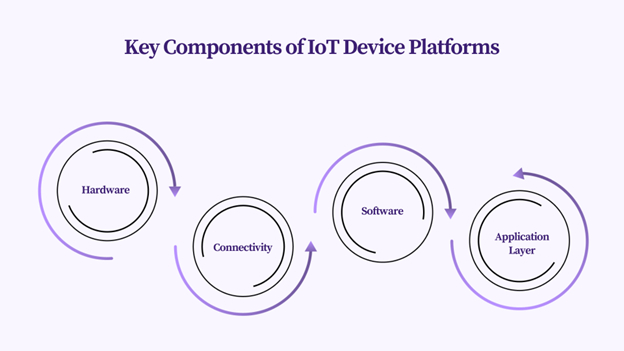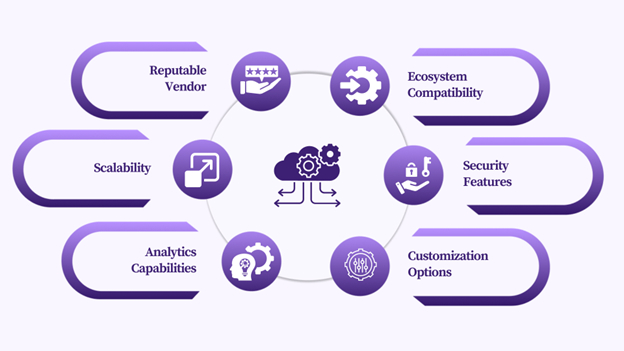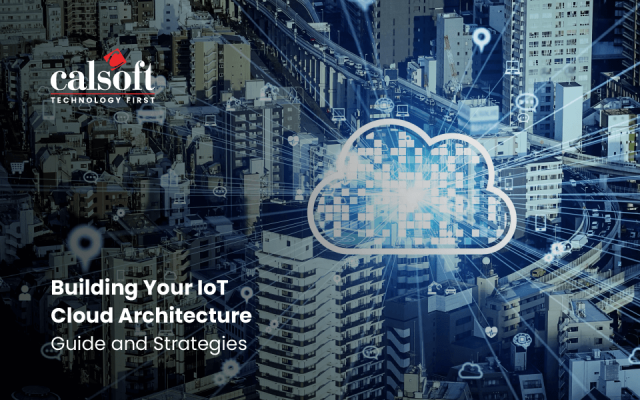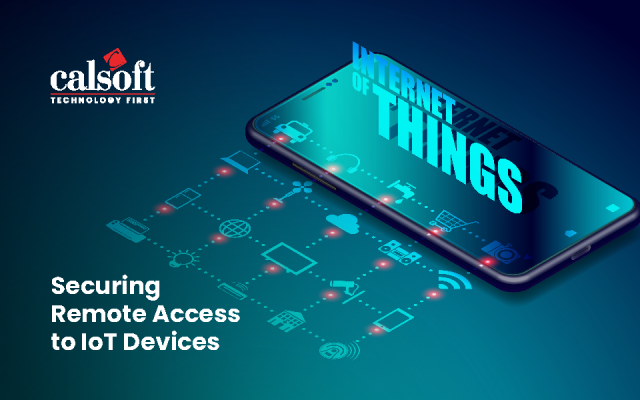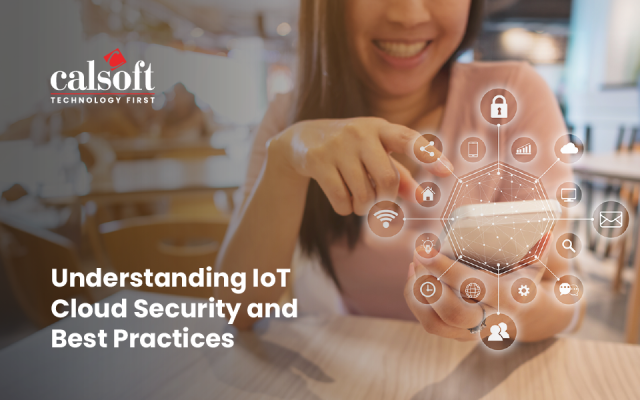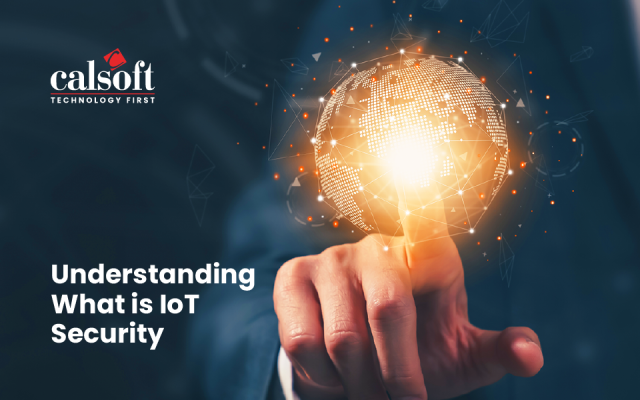The Internet of Things (IoT) has revolutionized how devices communicate, enabling seamless connectivity across various industries. IoT platforms are the backbone of this ecosystem, providing the necessary infrastructure and tools to manage, connect, and secure IoT devices.
Have you reached the critical point of choosing your IoT device platform? You’ve likely encountered similar opportunities from various providers, each with its challenges, making this decision more significant. After all, your choice of platform will determine how effectively you can scale and depend on operations—a crucial factor in the IoT world.
Markets and Markets research projected the global IoT market will grow to $650.5 billion by 2026. As more companies turn to IoT to enhance their operations, selecting the right platform can feel overwhelming.
This blog will detail the different types of IoT platforms, highlighting their strengths and how they meet different business needs.
What is an IoT Device Platform and its Key Components
An IoT device platform represents the central system for connecting, operating, and managing your IoT devices. To put it simply, it is the command center that controls your whole IoT ecosystem. It enables your devices to interact and process the data they generate.
Here’s how it works:
- Device Management: A platform that lets you connect thousands of devices and take control with one click. It will ensure that each device is correctly configured and remains up.
- Data Processing: It will gather and process data from all your devices. It transforms raw information into valuable insights and paves the route for swift decision-making.
- Security: An IoT platform will include all the capabilities required to protect current connections and prevent illegal access.
- Integration: It links to your existing systems and services, ensuring your IoT devices work smoothly with your business operations.
As technology improves, controlling more linked devices becomes more important. Let’s understand the critical components of IoT device platforms that make them essential today.
An IoT device platform comprises several essential elements, each crucial in ensuring the system operates smoothly. Here’s a closer look at these elements:
Hardware
Hardware includes sensors, actuators, and other connected devices. These form the basic software infrastructure and process various data inputs, such as environmental information from sensors (like temperature, humidity, etc.).
Actuators then use this data to perform actions, like turning on a machine or dimming lights. These components are the foundation of your IoT solution, enabling direct interaction with the real world.
Connectivity
Once data is collected, connectivity takes over, handling the crucial transmission task. It uses protocols like MQTT, HTTP, or CoAP to facilitate direct device-to-device and client/server communications, ensuring secure data transfer within a local network or over the Internet.
Software
The software acts as the intelligence behind the IoT platform. It processes data, manages devices, and provides analytics. This includes everything from ensuring devices function correctly to analyzing large amounts of real-time data.
Application Layer/User Interface
Application Layer is how you interact with the whole system, any Graphical User Interface (GUI), or in many ways, using API. It contains dashboards, mobile apps, and other tools for managing IoT devices. It permits real-time data visualization and assists customers in making decisions based on various insights they provide, thus all the prerequisites of ensuring a successful CI/CD pipeline layer for your system.
This combination offers a complete IoT platform. They work together to define an infrastructure that is reliable, scalable, and secure for your IoT requirements. An IoT platform connects the four components into a unified, controllable, and interpretable system. Now, let’s look at the types of IoT platform.
Types of IoT Device Platform
There are several types of IoT device platforms, each serving a specific purpose: End-to-End Platforms, Connectivity Platforms, and Cloud Platforms.
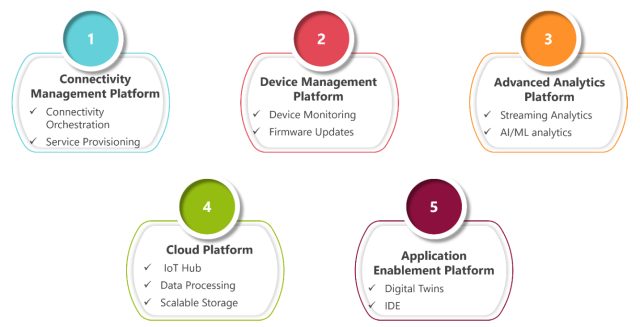
IoT Device Management Platform: IoT Device Management platforms manage the important, behind-the-scenes tasks for managing IoT devices. They ensure seamless connectivity and security, keeping you informed about the status of your devices. These platforms manage firmware updates, alert you to any changes, report key metrics, and apply security patches. Whether you have a few devices or thousands, a device Management platform updates the routine tasks, making it easier to maintain and monitor your IoT ecosystem.
IoT Connectivity Management Platform: Connectivity platforms ensure that your devices can communicate effectively. They manage the various communication methods, like Wi-Fi, Bluetooth, and cellular networks, keeping your devices securely connected.
IoT Cloud Platforms: Cloud platforms focus on data. These platforms handle storing, processing, and analyzing the information your devices generate. If you need real-time insights and the ability to make quick decisions, a Cloud Platform will serve you well.
IoT Application Enablement Platform: Your choice of platform depends on what you need most—whether it’s a fully integrated solution, reliable connectivity, or powerful data capabilities. Each platform has its strengths, so pick the one that aligns with your priorities and goals.
IoT Advanced Analytics Platform: IoT Advanced Analytics platforms are ideal for data-driven IoT ecosystems. These platforms cater to users who require complicated IoT systems that leverage Machine Learning (ML), Artificial Intelligence (AI), statistical modeling, and large-scale data collection. By interpreting and acting on the collected data, these platforms provide powerful and meaningful insights.
IoT End-to-End Platform: End-to-end platforms are complete solutions that handle everything from device management to data analysis. If you want a streamlined, all-in-one option, this is where you should focus.
Now that we have seen the different types of IoT device platforms let’s examine how to choose the right one for your business.
Key Consideration in Choosing an IoT Platform
You must carefully evaluate several factors to choose the best IoT platform for your business. Start by defining your specific use cases. Know what you want the platform to achieve and how it will fit your current systems. Here are some key considerations:
- Reputable Vendor: Choose a platform from a trusted company. Check its history and stability to ensure it can support your needs over time.
- Ecosystem Compatibility: Look for platforms with a robust partner ecosystem. This offers flexibility and options for expanding your IoT solution.
- Scalability: Ensure the platform can grow with your business. It should be able to handle more devices and data without losing performance.
- Security Features: Prioritize strong security measures. The platform should offer data protection and secure communications to keep sensitive information safe.
- Analytics Capabilities: Effective platforms provide tools to analyze data from your devices. This insight can help you make informed decisions and improve operations.
- Customization Options: Choose platforms that tailor features to your needs. Custom dashboards and data visualization tools enhance user experience.
In conclusion, selecting the right IoT device platform is crucial for improving business operations and ensuring long-term success. Considering these factors, you can find a solution that meets your needs and encourages growth.
IoT Platforms: Bridging Cloud and Edge
Many IoT platforms operate in the cloud, leveraging speed, scalability, cost-effectiveness, and global accessibility. However, for organizations managing remote assets, it’s crucial that an IoT platform also supports edge computing.
IoT edge computing brings data processing closer to the sensors, reducing the need to send a continuous stream of data to the cloud. This is particularly beneficial for organizations with devices in areas with limited connectivity, those generating large amounts of data that would be expensive to transmit to the cloud, or those requiring millisecond response times for analytics.
IoT edge computing exists on a spectrum. On one end, thin edge architecture collects and transmits device data for centralized processing. This lightweight, modular approach offers a quick, easy connection to established systems, especially for applications relying on low-powered, resource-constrained sensors.
On the other end of the spectrum is thick edge architecture, where data processing is decentralized and occurs closer to the source. For example, in an autonomous vehicle, onboard systems process sensor data directly, avoiding the high latency that would result from sending data to a distant server, ensuring safe and immediate responses to road conditions.
To fully leverage IoT edge computing, an IoT platform should allow you to develop solutions once and deploy them anywhere—whether in the cloud, at the edge, or on-premises. Also read the latest blog on IoT Cloud Security
Top IoT Device Platforms
In the coming years, choosing the right IoT platform as a service is crucial for any business wanting to tap into the Internet of Things. Each platform offers distinct features that cater to various needs. These factors play a significant role in the overall success of IoT implementations.
| IoT Platform | Features | Pros | Cons | Pricing Model |
| AWS IoT Core |
|
|
|
Pay-as-you-go pricing model with some free tier options for limited use. Costs can increase depending on the volume of data and number of connected devices. |
| Microsoft Azure IoT Hub |
|
|
|
Pay-as-you-go pricing model. It offers flexibility for various deployment scales.
|
| IBM Watson IoT |
|
|
|
Tailors its pricing to the business’s specific needs, focusing on enterprise-level deployments. |
| Bosch IoT Suite |
|
|
|
Tailors its pricing model to the specific needs of various industries, typically aiming at large enterprises. |
In short,
AWS IoT Core is a leading platform primarily known for its deep integration with the broader AWS ecosystem. It offers a robust suite of tools for cloud integration, advanced analytics, and device management, making it a preferred choice for enterprises already utilizing AWS services.
Microsoft Azure IoT Hub is an ideal platform for businesses in the Microsoft ecosystem. It seamlessly integrates with other Microsoft services, such as Azure Cloud and Microsoft 365. The platform is designed to support enterprise IoT needs with real-time data processing and robust scalability.
IBM Watson IoT is distinguished by its AI and machine learning integration into IoT applications. This platform provides real-time data analytics and predictive insights, making it particularly strong in industries requiring complex data processing.
Bosch IoT Suite is well-suited for industrial applications, with a strong emphasis on security and device management. It offers comprehensive data processing capabilities, making it ideal for industries that require secure and reliable IoT solutions.
Parting Thoughts
In summary, you must determine your business’s ideal IoT device platform and how you will use IoT commercially. Seeing the big picture will allow you to choose with your company objectives in mind.
The future of IoT platform companies is one where they will continue to evolve and innovate as we move forward. They will include more intricate technologies like machine learning and edge computing. These technologies will allow for higher data processing and analytics, helping deliver better results. Depending on the complexity of the IoT system, enterprises may require more than one IoT platform to ensure smooth operation. Combining a connectivity management platform to maintain device connectivity with an advanced analytics platform to process your collected data can prevent a large IoT system from becoming overwhelmed.
Calsoft being a technology-first company, develops enterprise-class, highly available, high-performance, secured, and intelligent systems to help our customers – large entities, mid-sized players, and startups – from the Manufacturing, Hi-tech, and Data Center spaces in their IoT adoption strategies. Calsoft offers intelligent frameworks and digital services to deliver IoT-powered solutions. Calsoft’s IoT services portfolio is comprehensive and designed to cater to the diverse needs of our clients.

